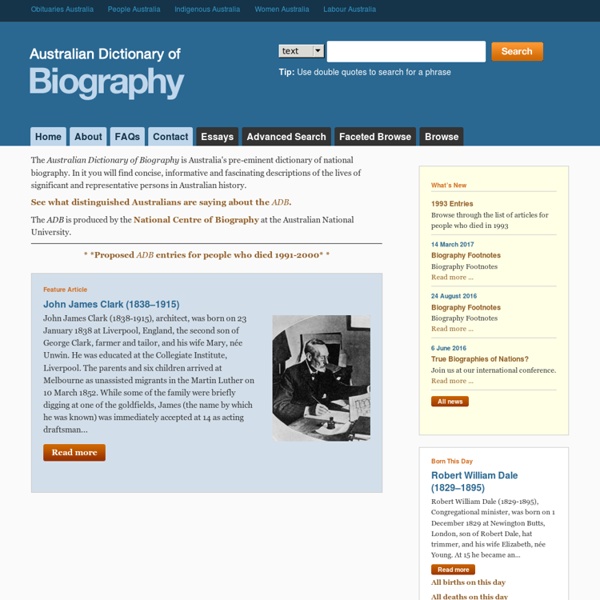



National Portrait Gallery, Canberra - Portraits Welcome to the National Portrait Gallery's collection search. The National Portrait Gallery's collection contains portraits depicted in a wide variety of media; paintings, sculptures, prints, drawings and photographs. Copyright Statement Forced Migration Throughout the 18th and 19th centuries, the British correctional system became severely overburdened. The population of England rose dramatically, and London soon became overcrowded. Poverty and social injustice were rife, child labour and long working hours were widespread, and living conditions were squalid and filthy. Many were unemployed, and crime was rampant. Black-eyed Sue and Sweet Poll of Plymouth taking leave of their lovers who are going to Botany Bay (Photo credit: Wikipedia) Britain’s police and penitentiary system were practically non-existent.
Australia's PMs - Australia's Prime Ministers Site map | Glossary | Contact us About this site | Australia's PMs | Fast facts | Timeline | Galleries | Find records > The Australian prime minister> The prime ministerial spouse Home > Australia's PMs Australian History: Post Federation: Sporting Achievements During the century of world wars and the Great Depression, Australia achieved great heights in sporting achievements. These are the main highlights of significant Australian performances. Sir Donald Bradman - Sir Donald Bradman is arguably the greatest cricketer of all time. His statistics are incredibly superior to anyone else even to this day. He played in 52 Test matches for Australia from 1928 to 1948. Sport Australia Hall of Fame - Legends of Australian Sport 2013 Induction & Awards Dinner News Feed 5th Feb 2014 Search
Australian Olympic Committee: Olympian Search Every Australian Olympian and their Games results can be found here. Simply type in the athlete name and search. For more advanced searches, you can use the drop down boxes to filter by Gender, Medal type, Sport, and Games. Ian Thorpe Ian Thorpe won five Olympic gold medals, the greatest total of any Australian. Australian painters John Glover (1767-1849), Australian landscape with cattle: the artist's property Patterdale, c. 1835, oil on canvas. Image courtesy of the : an2253188. When the first artists arrived in colonial Australia from Europe in the late 18th century, they were confronted by images and scenery the likes of which they had never seen: ...the whole appearance of nature must be striking in the extreme to the adventurer, and at first this will seem to him to be a country of enchantments.Thomas Watling, Letters From An Exile in Botany Bay, To His Aunt in Dumfries, 1794 The traditions of European art and painting did not fit comfortably with this strange and bewildering new landscape.
Why did the great journey's of exploration occur? In this part of your course you are investigating some of the great explorations in world history. During the fifteenth and sixteenth centuries there was a great outbreak of exploration from Europe to unknown areas of the world. Why did this happen? What was it like to be an explorer then, going into the unknown? What were they looking for? 1 Historical background Recognising Aboriginal and Torres Strait Islander Peoples in the Constitution: Report of the Expert Panel Millions of non-indigenous Australians have joined with us in the search for a better relationship based on equity and justice. Australians at every level of our society have put up their hands to be counted as supporters of a nation that holds as its core value a society based on mutual respect, tolerance and justice. ...
Collections in Melbourne: A Guide to Commonwealth Government Records - Collections in Melbourne: A Guide to Commonwealth Records Celia Blake Published by the National Archives of Australia This is guide number 8 in the series of research guides published by the National Archives. The Melbourne office of the National Archives of Australia holds a wealth of material that will interest both professional and family historians. The collection is especially rich because the original seat of the Commonwealth Parliament was located in Melbourne. Among the unique treasures are records on the administration of Aboriginal affairs in Victoria from 1860; drawings of the Port Phillip defences, 1880-1912; files on internees and prisoners of war held in Australia during World War II; and the Australian Women's Army Service records.